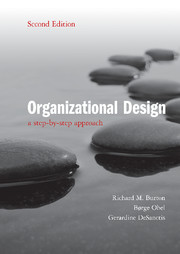Book contents
- Frontmatter
- Contents
- Figures
- Tables
- Preface to first edition
- Preface to second edition
- An outline of the step-by-step approach
- Step 1 Getting started
- Step 2 Strategy
- 2 Strategy
- 3 Environment
- Step 3 Structure
- Step 4 Process and people
- Step 5 Coordination and control
- Applying the step-by-step approach in a dynamic world
- References
- Index
2 - Strategy
from Step 2 - Strategy
Published online by Cambridge University Press: 05 June 2012
- Frontmatter
- Contents
- Figures
- Tables
- Preface to first edition
- Preface to second edition
- An outline of the step-by-step approach
- Step 1 Getting started
- Step 2 Strategy
- 2 Strategy
- 3 Environment
- Step 3 Structure
- Step 4 Process and people
- Step 5 Coordination and control
- Applying the step-by-step approach in a dynamic world
- References
- Index
Summary
Introduction
In the previous chapter you described an organizational unit of analysis and its goals. The next step in our step-by-step approach is to describe the strategy of the organization and the environment in which it operates. In this chapter we focus on strategy. A firm's strategy helps determine its organizational design. Our focus here is on describing your firm's strategy – not how or why the choice of a strategy is made. Chandler (1962) stated the fundamental relation in his now famous dictum, “structure follows strategy.” That is, given a strategy, there are some organizational structures which can implement that strategy better than others. Strategy is the end; structure is the means. Strategy is the operationalization of the firm's goals of efficiency and/or effectiveness; and the structure is the means to achieve them. In this chapter we will discuss which strategy should be pursued to obtain the goals decided in Chapter 1. This has to be done taking into account the environment in which the firm operates. Thus, “achieving high performance in a business results from establishing and maintaining a fit among three elements: the strategy of the firm, its organizational design, and the environment in which it operates” (Roberts, 2004, p. 12).
- Type
- Chapter
- Information
- Organizational DesignA Step-by-Step Approach, pp. 23 - 37Publisher: Cambridge University PressPrint publication year: 2011

